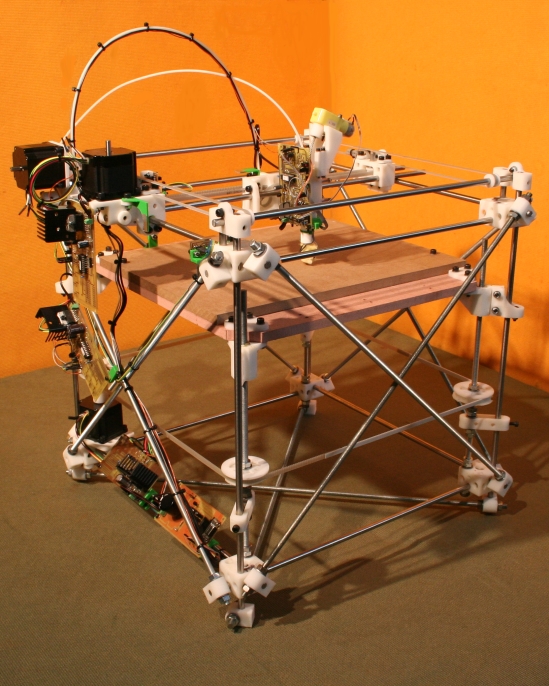|
Open Source Appropriate Technology
Open-source appropriate technology (OSAT) is appropriate technology developed through the principles of the open-design movement. Appropriate technology is technology designed with special consideration to the environmental, ethical, cultural, social, political, and economic aspects of the community it is intended for. Open design is public and licensed to allow it to be used, modified and distributed freely. Benefits Open source is a development method for appropriate technology that utilizes distributed peer review and transparency of process. Open-source-appropriate technology has potential to drive applied sustainability. The built-in continuous peer-review can result in better quality, higher reliability, and more flexibility than conventional design/patenting of technologies. The free nature of the knowledge provides lower costs, particularly for those technologies that benefit little from scale of manufacture. Finally, OSAT enables the end to predatory intellectual proper ... [...More Info...] [...Related Items...] OR: [Wikipedia] [Google] [Baidu] |
Appropriate Technology
Appropriate technology is a movement (and its manifestations) encompassing technological choice and application that is small-scale, affordable by locals, decentralized, labor-intensive, energy-efficient, environmentally sustainable, and locally autonomous. It was originally articulated as intermediate technology by the economist Ernst Friedrich "Fritz" Schumacher in his work ''Small Is Beautiful.'' Both Schumacher and many modern-day proponents of appropriate technology also emphasize the technology as people-centered. Appropriate technology has been used to address issues in a wide range of fields. Well-known examples of appropriate technology applications include: bike- and hand-powered water pumps (and other self-powered equipment), the universal nut sheller, self-contained solar lamps and streetlights, and passive solar building designs. Today appropriate technology is often developed using open source principles, which have led to ''open-source appropriate technolog ... [...More Info...] [...Related Items...] OR: [Wikipedia] [Google] [Baidu] |
Decentralization
Decentralization or decentralisation is the process by which the activities of an organization, particularly those regarding planning and decision making, are distributed or delegated away from a central, authoritative location or group. Concepts of decentralization have been applied to group dynamics and management science in private businesses and organizations, political science, law and public administration, economics, money and technology. History The word "''centralisation''" came into use in France in 1794 as the post-French Revolution, Revolution French Directory leadership created a new government structure. The word "''décentralisation''" came into usage in the 1820s. "Centralization" entered written English in the first third of the 1800s; mentions of decentralization also first appear during those years. In the mid-1800s Alexis de Tocqueville, Tocqueville would write that the French Revolution began with "a push towards decentralization...[but became,] in the e ... [...More Info...] [...Related Items...] OR: [Wikipedia] [Google] [Baidu] |
Sustainable Technologies
Environmentally sustainable design (also called environmentally conscious design, eco-design, etc.) is the philosophy of designing physical objects, the built environment, and services to comply with the principles of ecological sustainability and also aimed at improving the health and comfortability of occupants in a building.McLennan, J. F. (2004), The Philosophy of Sustainable Design Sustainable design seeks to reduce negative impacts on the environment, the health and well-being of building occupants, thereby improving building performance. The basic objectives of sustainability are to reduce the consumption of non-renewable resources, minimize waste, and create healthy, productive environments. Theory The sustainable design intends to "eliminate negative environmental impact through skillful sensitive design". Manifestations of sustainable design require renewable resources and innovation to impact the environment minimally, and connect people with the natural environmen ... [...More Info...] [...Related Items...] OR: [Wikipedia] [Google] [Baidu] |
Survival Skills
Survival skills are techniques that a person may use in order to sustain life in any type of natural environment or built environment. These techniques are meant to provide basic necessities for human life which include water, food, and shelter. These skills also support proper knowledge and interactions with animals and plants to promote the sustaining of life over a period of time. Survival skills are often associated with the need to survive in a disaster situation. Survival skills are often basic ideas and abilities that ancient people invented and used themselves for thousands of years. Outdoor activities such as hiking, backpacking, horseback riding, fishing, and hunting all require basic wilderness survival skills, especially in handling emergency situations. Bushcraft and primitive living are most often self-implemented but require many of the same skills. First aid First aid ( wilderness first aid in particular) can help a person survive and function with inj ... [...More Info...] [...Related Items...] OR: [Wikipedia] [Google] [Baidu] |
Technology By Type
Technology is the application of knowledge to reach practical goals in a specifiable and reproducible way. The word ''technology'' may also mean the product of such an endeavor. The use of technology is widely prevalent in medicine, science, industry, communication, transportation, and daily life. Technologies include physical objects like utensils or machines and intangible tools such as software. Many technological advancements have led to societal changes. The earliest known technology is the stone tool, used in the prehistoric era, followed by fire use, which contributed to the growth of the human brain and the development of language in the Ice Age. The invention of the wheel in the Bronze Age enabled wider travel and the creation of more complex machines. Recent technological developments, including the printing press, the telephone, and the Internet have lowered communication barriers and ushered in the knowledge economy. While technology contributes to econo ... [...More Info...] [...Related Items...] OR: [Wikipedia] [Google] [Baidu] |
Welcome To Appropedia
A welcome is a kind of greeting designed to introduce a person to a new place or situation, and to make them feel at ease. The term can similarly be used to describe the feeling of being accepted on the part of the new person. In some contexts, a welcome is extended to a stranger to an area or a household. "The concept of welcoming the stranger means intentionally building into the interaction those factors that make others feel that they belong, that they matter, and that you want to get to know them". It is also noted, however, that " many community settings, being welcoming is viewed as in conflict with ensuring safety. Thus, welcoming becomes somewhat self-limited: 'We will be welcoming unless you do something unsafe'". Different cultures have their own traditional forms of welcome, and a variety of different practices can go into an effort to welcome: Indications that visitors are welcome can occur at different levels. For example, a welcome sign, at the national, stat ... [...More Info...] [...Related Items...] OR: [Wikipedia] [Google] [Baidu] |
Sustainable Development
Sustainable development is an organizing principle for meeting human development goals while also sustaining the ability of natural systems to provide the natural resources and ecosystem services on which the economy and society depend. The desired result is a state of society where living conditions and resources are used to continue to meet human needs without undermining the integrity and stability of the natural system. Sustainable development was defined in the 1987 Brundtland Report as "Development that meets the needs of the present generation without compromising the ability of future generations to meet their own needs".United Nations General Assembly (1987''Report of the World Commission on Environment and Development: Our Common Future'' Transmitted to the General Assembly as an Annex to document A/42/427 – Development and International Co-operation: Environment. As the concept of sustainable development developed, it has shifted its focus more towards the ec ... [...More Info...] [...Related Items...] OR: [Wikipedia] [Google] [Baidu] |
Open Manufacturing
Open manufacturing, also known as open production, maker manufacturing, and with the slogan "Design Global, Manufacture Local" is a new model of socioeconomic production in which physical objects are produced in an open, collaborative and distributed mannerMichel Bauwens: The Emergence of Open Design and Open Manufacturing. In: We_magazine Volume 02 and based on open design and open source principles. Open manufacturing combines the following elements of a production process: new open production tools and methods (such as 3D printers), new value-based movements (such as the maker movement), new institutions and networks for manufacturing and production (such as FabLabs), and open source methods, software and protocols. Open manufacturing may also include digital modeling and fabrication and computer numeric control (CNC) of the machines used for production through open source software and open source hardware. The philosophy of open manufacturing is close to the open-source mo ... [...More Info...] [...Related Items...] OR: [Wikipedia] [Google] [Baidu] |
Open Design
The open-design movement involves the development of physical products, machines and systems through use of publicly shared design information. This includes the making of both free and open-source software (FOSS) as well as open-source hardware. The process is generally facilitated by the Internet and often performed without monetary compensation. The goals and philosophy of the movement are identical to that of the open-source movement, but are implemented for the development of physical products rather than software. Open design is a form of co-creation, where the final product is designed by the users, rather than an external stakeholder such as a private company. Origin Sharing of manufacturing information can be traced back to the 18th and 19th century. Aggressive patenting put an end to that period of extensive knowledge sharing. More recently, principles of open design have been related to the free and open-source software movements.Vallance, Kiani and Nayfeh, Open D ... [...More Info...] [...Related Items...] OR: [Wikipedia] [Google] [Baidu] |
Engineering For Change
Engineering for Change (E4C) is an online platform and international community of engineers, scientists, non-governmental organizations, local community advocates and other innovators working to solve global development problems. The organization's founding partners are the American Society of Mechanical Engineers, the Institute of Electrical and Electronics Engineers, and Engineers Without Borders USA. It is now under the umbrella of ASME's Engineering for Global Development program. Collaborators include Siemens Stiftung, The Level Market, Autodesk Foundation, Global Alliance for Clean Cookstoves, CAWST, WFEO, ITU, Institute of Food Technologists, and United Nations Major Group for Children and Youth. E4C facilitates the development of affordable, locally appropriate and sustainable solutions to the most pressing humanitarian challenges and shares them freely online as a form of open source appropriate technology. Members of the E4C community use the platform's online tools t ... [...More Info...] [...Related Items...] OR: [Wikipedia] [Google] [Baidu] |
Appropriate Technology
Appropriate technology is a movement (and its manifestations) encompassing technological choice and application that is small-scale, affordable by locals, decentralized, labor-intensive, energy-efficient, environmentally sustainable, and locally autonomous. It was originally articulated as intermediate technology by the economist Ernst Friedrich "Fritz" Schumacher in his work ''Small Is Beautiful.'' Both Schumacher and many modern-day proponents of appropriate technology also emphasize the technology as people-centered. Appropriate technology has been used to address issues in a wide range of fields. Well-known examples of appropriate technology applications include: bike- and hand-powered water pumps (and other self-powered equipment), the universal nut sheller, self-contained solar lamps and streetlights, and passive solar building designs. Today appropriate technology is often developed using open source principles, which have led to ''open-source appropriate technolog ... [...More Info...] [...Related Items...] OR: [Wikipedia] [Google] [Baidu] |
Applied Sustainability
Applied sustainability is the application of science and innovation, including the insights of the social sciences, to meet human needs while indefinitely preserving the life support systems of the planet. Note that this is a significant difference from the standard definition of sustainability that normally is encapsulated by some version of the Brundtland Commission's concept: “development that meets the needs and aspirations of the present without compromising the ability of future generations to meet their own needs” Just applied sustainability A more refined definition would be called "just applied sustainability": the just and equitable application of science and innovation, including the social sciences, to ensure a better quality of life for all, now and into the future whilst living within the limits of supporting ecosystems. This comes from the definition of Just Sustainability, which is "the egalitarian conception of sustainable development". It generat ... [...More Info...] [...Related Items...] OR: [Wikipedia] [Google] [Baidu] |





